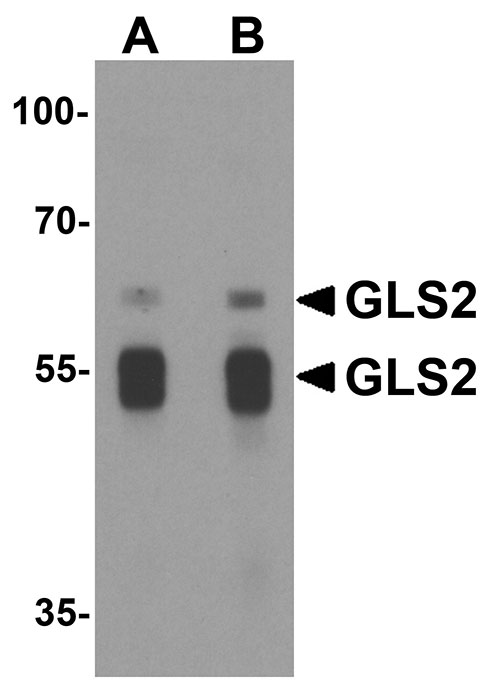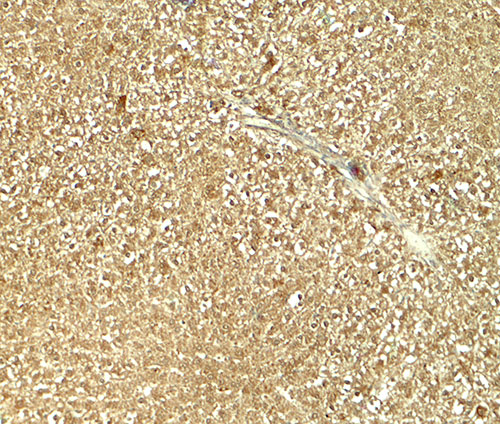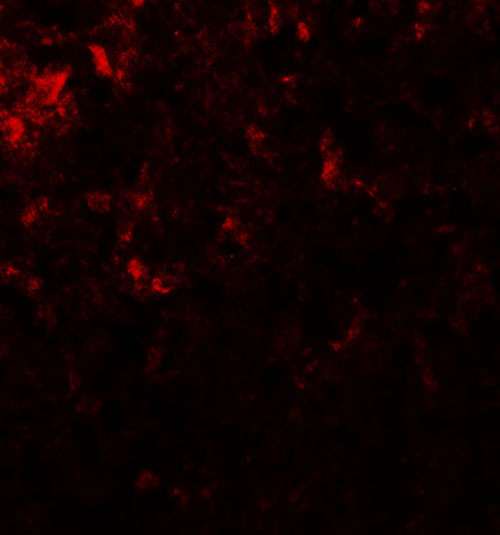GLS2 Antibody
- 产品详情
- 实验流程
- 背景知识
Application
| WB, IF, E, IHC-P |
|---|---|
| Primary Accession | Q9UI32 |
| Other Accession | NP_037399, 20336214 |
| Reactivity | Human, Mouse, Rat |
| Host | Rabbit |
| Clonality | Polyclonal |
| Isotype | IgG |
| Calculated MW | 66323 Da |
| Concentration (mg/ml) | 1 mg/mL |
| Conjugate | Unconjugated |
| Application Notes | GLS2 antibody can be used for detection of GLS2 by Western blot at 0.5 - 1 µg/mL. Antibody can also be used for immunohistochemistry starting at 5 µg/mL. For immunofluorescence start at 20 µg/mL. |
| Gene ID | 27165 |
|---|---|
| Other Names | Glutaminase liver isoform, mitochondrial, GLS, 3.5.1.2, L-glutaminase, L-glutamine amidohydrolase, GLS2, GA |
| Target/Specificity | GLS2; Multiple isoforms of GLS2 are known to exist. |
| Reconstitution & Storage | GLS2 antibody can be stored at 4℃ for three months and -20℃, stable for up to one year. As with all antibodies care should be taken to avoid repeated freeze thaw cycles. Antibodies should not be exposed to prolonged high temperatures. |
| Precautions | GLS2 Antibody is for research use only and not for use in diagnostic or therapeutic procedures. |
| Name | GLS2 |
|---|---|
| Synonyms | GA |
| Function | Plays an important role in the regulation of glutamine catabolism. Promotes mitochondrial respiration and increases ATP generation in cells by catalyzing the synthesis of glutamate and alpha- ketoglutarate. Increases cellular anti-oxidant function via NADH and glutathione production. May play a role in preventing tumor proliferation. |
| Cellular Location | Mitochondrion. |
| Tissue Location | Highly expressed in liver. Expressed in brain and pancreas. Not observed in heart, placenta, lung, skeletal muscle and kidney. Expression is significantly reduced in hepatocellular carcinomas. |
For Research Use Only. Not For Use In Diagnostic Procedures.
Provided below are standard protocols that you may find useful for product applications.
BACKGROUND
GLS2 Antibody: Phosphate-activated glutaminase, also known as Glutaminase 2 (GLS2), was initially isolated from rat liver, although it has been shown to be expressed in other tissues. Like the functionally similar, larger kidney glutaminase, GLS2 catalyzes the hydrolysis of glutamine to stoichiometric amounts of glutamate and ammonia. Expression of GLS2 is increased by p53 under both stressed and nonstressed conditions, resulting in increased levels of glutamate and alpha-ketoglutarate, which in turn results in enhanced mitochondrial respiration and ATP generation. GLS2 also regulates antioxidant defense function in cells by increasing reduced glutathione levels and decreasing ROS-levels, suggesting that GLS2 acts as a mediator of p53's role in antioxidant defense in addition to its role in energy metabolism.
REFERENCES
Chung-Bok MI, Vincent N, Jhala U, et al. Rat hepatic glutaminase: identification of the full coding sequence and characterization of a functional promoter. Biochem. J. 1997; 324:193-200.
Gomez-Fabre PM, Aledo JC, del Castillo-Olivares A, et al. Molecular cloning, sequencing and expression studies of the human breast cancer cell glutaminase. Biochem. J. 2000; 345:365-75.
Hu W, Zhang C, Wu R, et al. Glutaminase 2, a novel p53 target gene regulating energy metabolism and antioxidant function. Proc. Natl. Acad. Sci. USA 2010; 107:7455-60.
终于等到您。ABCEPTA(百远生物)抗体产品。
点击下方“我要评价 ”按钮提交您的反馈信息,您的反馈和评价是我们最宝贵的财富之一,
我们将在1-3个工作日内处理您的反馈信息。
如有疑问,联系:0512-88856768 tech-china@abcepta.com.























 癌症的基本特征包括细胞增殖、血管生成、迁移、凋亡逃避机制和细胞永生等。找到癌症发生过程中这些通路的关键标记物和对应的抗体用于检测至关重要。
癌症的基本特征包括细胞增殖、血管生成、迁移、凋亡逃避机制和细胞永生等。找到癌症发生过程中这些通路的关键标记物和对应的抗体用于检测至关重要。 为您推荐一个泛素化位点预测神器——泛素化分析工具,可以为您的蛋白的泛素化位点作出预测和评分。
为您推荐一个泛素化位点预测神器——泛素化分析工具,可以为您的蛋白的泛素化位点作出预测和评分。 细胞自噬受体图形绘图工具为你的蛋白的细胞受体结合位点作出预测和评分,识别结合到自噬通路中的蛋白是非常重要的,便于让我们理解自噬在正常生理、病理过程中的作用,如发育、细胞分化、神经退化性疾病、压力条件下、感染和癌症。
细胞自噬受体图形绘图工具为你的蛋白的细胞受体结合位点作出预测和评分,识别结合到自噬通路中的蛋白是非常重要的,便于让我们理解自噬在正常生理、病理过程中的作用,如发育、细胞分化、神经退化性疾病、压力条件下、感染和癌症。








